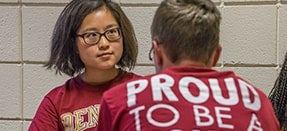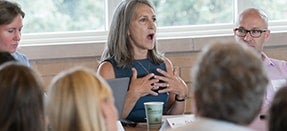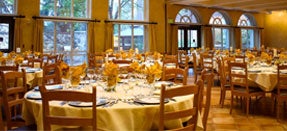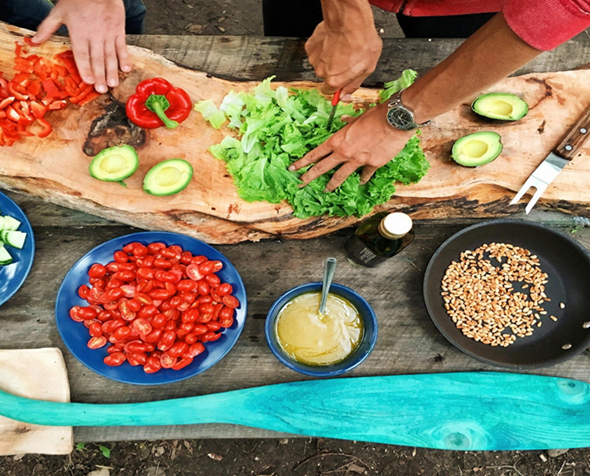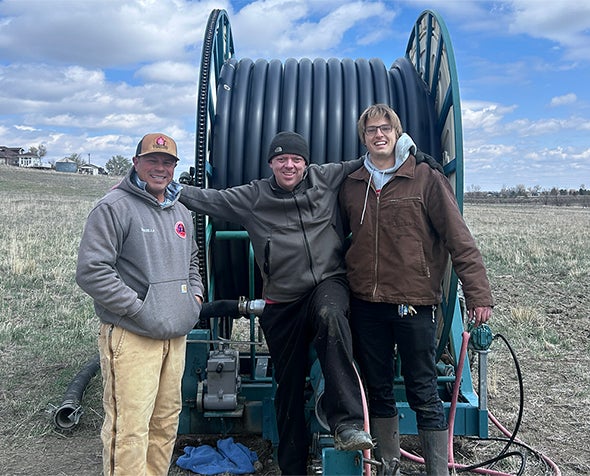The Art of Bookbinding Comes to DU
The prestigious Open·Set Exhibition, featuring the world’s best book binders, is on display in Anderson Academic Commons until August 10.

First place winner in the "Set" category
In today’s world, most books are produced in massive warehouses, churned out by the thousands. Stacks of paper whirl through a series of machines—pushed, pressed, and bound into a sleek commercial product destined for store shelves.
In contrast, the art of fine bookbinding stands as a quiet act of devotion measured by millimeters, stitched by hand, and shaped by years of study. The result isn’t only a book but a work of art: a love letter bound to the text inside.
The work of award-winning bookbinders from around the globe are currently on display in the the University of Denver’s Anderson Academic Commons in an exhibition titled “Open·Set,” which honors the precision, creativity, and passion behind bookbinding.
“It’s a really beautiful interdisciplinary art and craft. It’s engineering. It’s chemistry. It brings together all these different fields that both create something that’s high art and functional,” says Kate Crowe, curator of special collections and archives at University Libraries.
The triennial Open·Set competition and exhibition is sponsored by the American Academy of Bookbinding and organized by longtime binder and educator Lang Ingalls. Books are judged by a panel of jurors based on craftsmanship, design and aesthetic, technical complexity, originality and overall execution. There are two categories: the open category, where binders choose their own text block to bind, and the set category, where all participants bind the same book. This year’s book was the “Helen Fragments,” a collection of books from Homer’s “Iliad.”
For Ingalls, the significance of bookbinding is more than craftmanship or competition. “Bookbinding brought literacy to the public. It’s one of the biggest impacts on humanity,” she says .
Colorado winner shares her bookbinding story
Brenda Gallagher, a Boulder resident, was one of this year’s winners and has two books featured in the exhibition. Before she discovered bookbinding, Gallagher was a graphic designer who worked on magazines but longed for a deeper connection to her work.
“As I was sitting there making my magazines and books, I started to feel a disconnect between what I was doing and what I was making,” Gallagher says. “You’re clicking the mouse as the season passes by. Six weeks later, the magazines show up on trucks.”
She took her first bookbinding class in 1995 and has been hooked ever since. As a first-year student, she was told she was born for this work. That set her on a path she’ll never forget, which began at her kitchen table.
For Gallagher, bookbinding engages her whole being—smelling the leather, feeling the paper, listening to the vintage equipment, and seeing the final product. Bookbinding, she says, involves the details of the details. It’s little, tiny measurements or changes that have an overall impact in introducing the reader to the work of art inside.
“Our voices work in chorus with the originators of the text,” she says.
Gallagher submitted in both the open and set categories. For the open category, she chose to bind “A Lyttle Booke of Nonsense” by Randall Davies, a collection of limericks and whimsical tales. As she dove into the text, she noticed the pattern of rectangles of different shapes on every page. So, she came up with a design of repeating rectangles on the cover.
“I used a tool to deboss and a little square tool to gopher a pattern into the surface,” Gallagher explains. “The headbands I sewed onto the rust-colored top edge were light, while the tail of the book retained the natural color of the paper, with a different end band sewn on. Using two different colored end bands felt kind of playful—I liked that.”
She won a “highly commendable” award for her treatment of flyleaves, the blank pages at the beginning or end of the book. She dyed the flyleaves black and added a die-cut design of playful rectangles, revealing glimpses of orange- and rust-colored front matter beneath—a theme woven throughout the book.
The bindings that Gallagher and other bookbinders create are designed to last hundreds of years, unlike that of a commercially bound book.
“It’s a consumable. It’s entirely possible to love your books. But 50 years from now, when you go to give them to someone, they will fall apart,” Gallagher says.
The works in the Open·Set exhibit also reflect a dazzling range of techniques and materials, each one a labor of love and intention.
One submission is bound in Tyvek, painted and embroidered over cheesecloth. Another from a Japanese artist incorporates hand-dyed silk made from cherry blossoms, spun into thread, woven into book cloth, and used to cover the boards—a process that took nearly a year.
The craftsmanship goes beyond aesthetics—it’s a feat of engineering. Bookbinders draw on chemistry, mechanics, textiles, and design. From hollow spines for smoother opening to carefully chosen adhesives and materials, every detail is intentional. One contestant even invented a new structure, the "duchy structure," named after her book’s two protagonists.
Since 2004, DU’s book arts collection has explored how a book’s material form shapes the reading experience. In an increasingly digital age, this exhibit reminds us of the tactile and lasting power of a physical book.
“Open·Set” is on display through Aug. 10.
